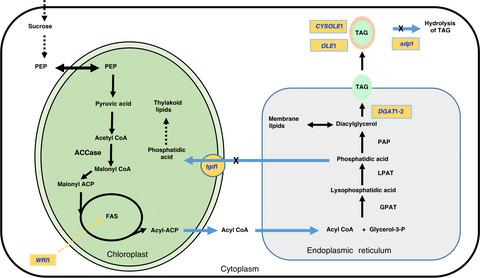当前位置:
X-MOL 学术
›
GCB Bioenergy
›
论文详情
Our official English website, www.x-mol.net, welcomes your feedback! (Note: you will need to create a separate account there.)
Towards oilcane: Engineering hyperaccumulation of triacylglycerol into sugarcane stems
Global Change Biology Bioenergy ( IF 5.6 ) Pub Date : 2020-05-23 , DOI: 10.1111/gcbb.12684 Saroj Parajuli 1 , Baskaran Kannan 1, 2 , Ratna Karan 1 , Georgina Sanahuja 1 , Hui Liu 3, 4 , Eva Garcia‐Ruiz 5 , Deepak Kumar 6 , Vijay Singh 6, 7 , Huimin Zhao 5, 7 , Stephen Long 7, 8 , John Shanklin 3, 4 , Fredy Altpeter 1, 2
Global Change Biology Bioenergy ( IF 5.6 ) Pub Date : 2020-05-23 , DOI: 10.1111/gcbb.12684 Saroj Parajuli 1 , Baskaran Kannan 1, 2 , Ratna Karan 1 , Georgina Sanahuja 1 , Hui Liu 3, 4 , Eva Garcia‐Ruiz 5 , Deepak Kumar 6 , Vijay Singh 6, 7 , Huimin Zhao 5, 7 , Stephen Long 7, 8 , John Shanklin 3, 4 , Fredy Altpeter 1, 2
Affiliation

|
Metabolic engineering to divert carbon flux from sucrose to oil in high biomass crop like sugarcane is an emerging strategy to boost lipid yields per hectare for biodiesel production. Sugarcane stems comprise more than 70% of the crops' biomass and can accumulate sucrose in excess of 20% of their extracted juice. The energy content of oils in the form of triacylglycerol (TAG) is more than twofold that of carbohydrates. Here, we report a step change in TAG accumulation in sugarcane stem tissues achieving an average of 4.3% of their dry weight (DW) in replicated greenhouse experiments by multigene engineering. The metabolic engineering included constitutive co‐expression of wrinkled1; diacylglycerol acyltransferase1‐2; cysteine‐oleosin; and ribonucleic acid interference‐suppression of sugar‐dependent1. The TAG content in leaf tissue was also elevated by more than 400‐fold compared to non‐engineered sugarcane to an average of 8.0% of the DW and the amount of total fatty acids reached about 13% of the DW. With increasing TAG accumulation an increase of 18:1 unsaturated fatty acids was observed at the expense of 16:0 and 18:0 saturated fatty acids. Total biomass accumulation, soluble lignin, Brix and juice content were significantly reduced in the TAG hyperaccumulating sugarcane lines. Overcoming this yield drag by engineering lipid accumulation into late stem development will be critical to exceed lipid yields of current oilseed crops.
中文翻译:

走向甘蔗:将三酰基甘油工程化地积累到甘蔗茎中
在高生物量作物(如甘蔗)中,通过代谢工程将碳通量从蔗糖转移到油中,这是提高每公顷生物柴油生产中脂质产量的新兴战略。甘蔗茎占作物生物量的70%以上,并且蔗糖的积累量超过提取汁液的20%。三酰基甘油(TAG)形式的油的能量含量是碳水化合物的两倍以上。在这里,我们报告了在通过多基因工程进行的重复温室试验中,甘蔗茎组织中TAG积累的阶跃变化,平均达到其干重(DW)的4.3%。代谢工程包括皱纹的组成型共表达1。二酰基甘油酰基转移酶1-2; 半胱氨酸-油质蛋白; 和核糖核酸干扰抑制糖依赖性1。与未加工的甘蔗相比,叶片组织中的TAG含量也提高了400倍以上,平均DW达到8.0%,总脂肪酸含量达到DW的13%左右。随着TAG积累的增加,观察到18:1不饱和脂肪酸的增加,以16:0和18:0饱和脂肪酸为代价。TAG超积累甘蔗品系的总生物量积累,可溶性木质素,白利糖度和果汁含量显着降低。通过将脂质积累工程化为茎的后期发育来克服这一产量拖累,对于超出目前油料作物的脂质产量至关重要。以16:0和18:0的饱和脂肪酸为代价,观察到1种不饱和脂肪酸。TAG超积累甘蔗品系的总生物量积累,可溶性木质素,白利糖度和果汁含量显着降低。通过将脂质积累工程化为茎的后期发育来克服这一产量拖累,对于超出目前油料作物的脂质产量至关重要。以16:0和18:0的饱和脂肪酸为代价,观察到1种不饱和脂肪酸。TAG超积累甘蔗品系的总生物量积累,可溶性木质素,白利糖度和果汁含量显着降低。通过将脂质积累工程化为茎的后期发育来克服这一产量拖累,对于超出目前油料作物的脂质产量至关重要。
更新日期:2020-05-23
中文翻译:

走向甘蔗:将三酰基甘油工程化地积累到甘蔗茎中
在高生物量作物(如甘蔗)中,通过代谢工程将碳通量从蔗糖转移到油中,这是提高每公顷生物柴油生产中脂质产量的新兴战略。甘蔗茎占作物生物量的70%以上,并且蔗糖的积累量超过提取汁液的20%。三酰基甘油(TAG)形式的油的能量含量是碳水化合物的两倍以上。在这里,我们报告了在通过多基因工程进行的重复温室试验中,甘蔗茎组织中TAG积累的阶跃变化,平均达到其干重(DW)的4.3%。代谢工程包括皱纹的组成型共表达1。二酰基甘油酰基转移酶1-2; 半胱氨酸-油质蛋白; 和核糖核酸干扰抑制糖依赖性1。与未加工的甘蔗相比,叶片组织中的TAG含量也提高了400倍以上,平均DW达到8.0%,总脂肪酸含量达到DW的13%左右。随着TAG积累的增加,观察到18:1不饱和脂肪酸的增加,以16:0和18:0饱和脂肪酸为代价。TAG超积累甘蔗品系的总生物量积累,可溶性木质素,白利糖度和果汁含量显着降低。通过将脂质积累工程化为茎的后期发育来克服这一产量拖累,对于超出目前油料作物的脂质产量至关重要。以16:0和18:0的饱和脂肪酸为代价,观察到1种不饱和脂肪酸。TAG超积累甘蔗品系的总生物量积累,可溶性木质素,白利糖度和果汁含量显着降低。通过将脂质积累工程化为茎的后期发育来克服这一产量拖累,对于超出目前油料作物的脂质产量至关重要。以16:0和18:0的饱和脂肪酸为代价,观察到1种不饱和脂肪酸。TAG超积累甘蔗品系的总生物量积累,可溶性木质素,白利糖度和果汁含量显着降低。通过将脂质积累工程化为茎的后期发育来克服这一产量拖累,对于超出目前油料作物的脂质产量至关重要。



























 京公网安备 11010802027423号
京公网安备 11010802027423号